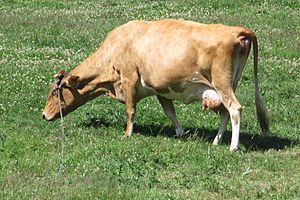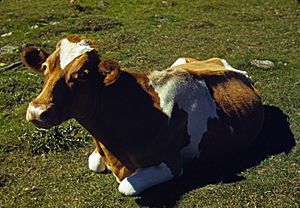Guernsey cattle facts for kids
 |
|
| Conservation status | FAO (2007): not at risk |
|---|---|
| Country of origin | Guernsey, Channel Islands |
| Distribution | world-wide |
| Use | milk |
| Traits | |
| Weight |
|
| Coat | fawn or red and white |
| Horn status | horned |
|
|

The Guernsey is a special type of cattle that gives milk. It comes from the island of Guernsey in the Channel Islands. These cows are usually fawn (light brown) or red and white. They are known for being strong and gentle. Their milk tastes great and has lots of fat and protein. It also has a pretty golden-yellow color because of something called β-carotene. The Guernsey is one of three kinds of cattle from the Channel Islands. The others are the Jersey and the Alderney, which doesn't exist anymore.
Contents
History of the Guernsey Breed
The Guernsey cattle breed was developed on the British Channel Island of Guernsey. People first wrote about this breed in the 1800s, but exactly where it came from is not fully known.
Cattle were first brought to the island in the Middle Ages. They were used for pulling carts and farm work. Some people think the Guernsey breed came from cattle brought from France. These might have included brindled cattle from Normandy and wheat-colored cattle like the Froment du Léon from Brittany. There might also have been some influence from Dutch cattle in the 1700s.
During the 1700s, many cattle were sent from the Channel Islands to England. Some of these cattle had first been brought from France. In 1819, a law was made to stop bringing French cattle to Guernsey. However, some British cattle were still brought in until 1877. During the Second World War, some cattle from Alderney were moved to Guernsey and mixed with the breed.
For a while, selling Guernsey cattle and their semen was an important way for the island to make money. In the early 1900s, many Guernsey cattle were sent to the United States. Today, the Guernsey breed is on a "watch list" in the U.S. This means there are fewer than 2,500 new registrations each year. The total number of these animals around the world is thought to be less than 10,000.
What Makes Guernsey Cattle Special?
Guernsey cattle are a medium-sized breed. Adult cows usually weigh between 450 and 500 kilograms. Bulls are heavier, weighing from 600 to 700 kilograms. Their coats are red or fawn (a light brown color). They can also have patches of red-and-white or fawn-and-white.
Guernsey cows are famous for their rich and tasty milk. In the past, they were also known for living a long time and having calves easily. They were good at grazing and produced a lot of milk for their size. However, some modern breeding methods have changed them. These methods have made the animals larger and taller. This means they don't always have the same good qualities as the traditional breed. This is especially true when they are cross-bred with Holstein-Friesian cows.
How Guernsey Cattle Are Used
The Guernsey is a dairy breed. This means they are mostly raised to produce milk. After about six to eight years, cows are usually taken out of the dairy herd. Then, they are often used for beef and other processed meats.
Guernsey milk has a golden-yellow color. This is because it has a lot of β-carotene. This is a special substance that the body can turn into vitamin A. The milk also has a high butterfat content, about 5%. It also has a good amount of protein, about 3.7%. On average, a Guernsey cow can produce around 6,000 liters of milk each year.
See also
 In Spanish: Guernsey (raza bovina) para niños
In Spanish: Guernsey (raza bovina) para niños


